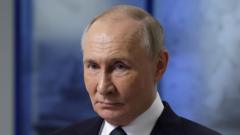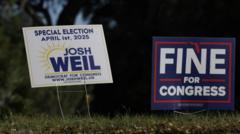As the war in Ukraine rages on, President Vladimir Putin's recent maneuvers highlight his reluctance to engage in meaningful negotiations with Ukrainian officials, despite a warmer stance from the U.S.
Putin’s Aggression Continues Despite U.S. Outreach

Putin’s Aggression Continues Despite U.S. Outreach
The Russian leader remains unyielding amid U.S. efforts for peace, persisting in bombarding Ukraine and complicating negotiations.
In the past two months, the White House has shown an unusual openness towards the Kremlin, but Putin’s actions tell a different story. His forces have intensified their bombardments across Ukraine, targeting both front lines and urban centers alike, while he remains unmoved in peace talks that are burdened with his stipulations. The Russian president has tied an unconditional 30-day ceasefire to numerous conditions which complicates matters further.
Just last week, during an appearance in the Arctic, he suggested it may be necessary to set up a temporary Ukrainian government under UN oversight, hinting that peace might be a far-off goal. This is compounded by Russia’s campaign to portray Ukrainian President Volodymyr Zelensky as an illegitimate leader, making negotiations even less likely.
In response to these developments, U.S. President Donald Trump expressed frustration over Russia's stance, threatening potential tariffs on Russian oil if peace talks fail. This could significantly impact Russia's economy, which heavily relies on oil exports. Trump emphasized the need for accountability in the ongoing conflict, underlining the complexities the U.S. faces in mediating between Moscow and Kyiv.
As the situation evolves, the unfolding dynamics between the U.S., Russia, and Ukraine continue to reveal deep-seated tensions and raise questions about the prospect of lasting peace in the region.
Just last week, during an appearance in the Arctic, he suggested it may be necessary to set up a temporary Ukrainian government under UN oversight, hinting that peace might be a far-off goal. This is compounded by Russia’s campaign to portray Ukrainian President Volodymyr Zelensky as an illegitimate leader, making negotiations even less likely.
In response to these developments, U.S. President Donald Trump expressed frustration over Russia's stance, threatening potential tariffs on Russian oil if peace talks fail. This could significantly impact Russia's economy, which heavily relies on oil exports. Trump emphasized the need for accountability in the ongoing conflict, underlining the complexities the U.S. faces in mediating between Moscow and Kyiv.
As the situation evolves, the unfolding dynamics between the U.S., Russia, and Ukraine continue to reveal deep-seated tensions and raise questions about the prospect of lasting peace in the region.





















